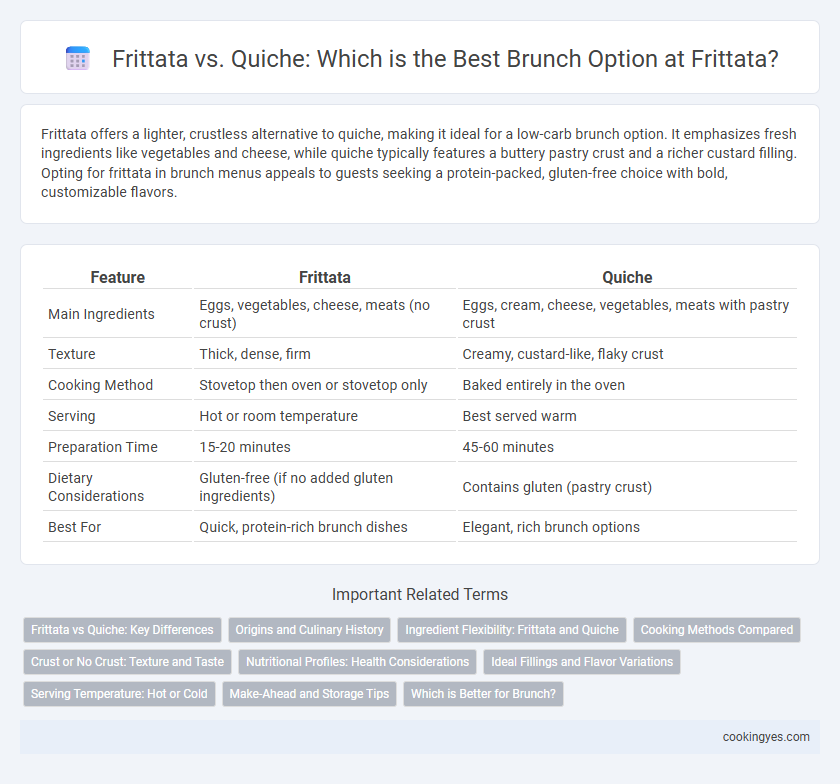Frittata offers a lighter, crustless alternative to quiche, making it ideal for a low-carb brunch option. It emphasizes fresh ingredients like vegetables and cheese, while quiche typically features a buttery pastry crust and a richer custard filling. Opting for frittata in brunch menus appeals to guests seeking a protein-packed, gluten-free choice with bold, customizable flavors.
Table of Comparison
| Feature | Frittata | Quiche |
|---|---|---|
| Main Ingredients | Eggs, vegetables, cheese, meats (no crust) | Eggs, cream, cheese, vegetables, meats with pastry crust |
| Texture | Thick, dense, firm | Creamy, custard-like, flaky crust |
| Cooking Method | Stovetop then oven or stovetop only | Baked entirely in the oven |
| Serving | Hot or room temperature | Best served warm |
| Preparation Time | 15-20 minutes | 45-60 minutes |
| Dietary Considerations | Gluten-free (if no added gluten ingredients) | Contains gluten (pastry crust) |
| Best For | Quick, protein-rich brunch dishes | Elegant, rich brunch options |
Frittata vs Quiche: Key Differences
Frittata features a crustless egg base mixed with vegetables, meats, and cheeses, offering a lighter, protein-rich option compared to quiche, which contains a buttery pastry crust and a custard-like egg and cream filling. Frittata is typically cooked on the stovetop and finished in the oven, resulting in a fluffy, open-faced dish that is easier to slice and serve than the denser, richer quiche. For brunch offerings, frittata caters to gluten-free diets and those seeking a lower-fat alternative, while quiche provides a more indulgent, traditional choice with its distinct flaky texture.
Origins and Culinary History
Frittata, originating from Italy, dates back to the Renaissance period and is characterized by its open-faced, oven-cooked egg base mixed with vegetables, cheese, or meats. In contrast, Quiche, rooted in French cuisine, emerged in the medieval Kingdom of Lothringen and features a pastry crust filled with a custard of eggs, cream, and various ingredients. These distinct culinary histories influence their textures and flavors, making frittatas a lighter, rustic option compared to the rich, decadent quiche often favored for brunch menus.
Ingredient Flexibility: Frittata and Quiche
Frittatas offer greater ingredient flexibility by allowing a wide range of vegetables, meats, and cheeses to be mixed directly into the egg base without the need for a crust, making them ideal for customizable brunch menus. Quiches require a pastry crust and typically incorporate cream or milk for a richer, custard-like texture, which can limit ingredient variations due to the delicate balance needed for proper setting. Choosing frittata over quiche can simplify preparation and enable more creative use of seasonal ingredients in brunch offerings.
Cooking Methods Compared
Frittata is cooked primarily on the stovetop with a brief oven finish, resulting in a fluffy, open-faced egg dish without a crust. Quiche involves baking eggs mixed with cream or milk inside a pastry crust, yielding a denser, custard-like texture with a buttery base. The stovetop-to-oven technique of frittata allows faster preparation and lighter mouthfeel, while quiche's baking method emphasizes rich, layered flavors and a firm structure.
Crust or No Crust: Texture and Taste
Frittatas offer a crustless option that provides a dense, custard-like texture with a rich blend of eggs and fillings, appealing to those seeking a lighter, gluten-free choice. In contrast, quiches feature a flaky, buttery crust that adds a crisp texture and an additional layer of savory flavor, complementing the creamy egg custard inside. The presence or absence of crust significantly influences the overall mouthfeel and taste experience, making frittatas ideal for a simpler, more protein-focused brunch and quiches better for those desiring a more indulgent, textured dish.
Nutritional Profiles: Health Considerations
Frittatas offer a high-protein, low-carb option rich in vitamins and minerals from vegetables, making them ideal for health-conscious brunch menus. Quiches contain a buttery crust that increases saturated fat and calorie content, which may be less suitable for those monitoring cholesterol or weight. Both dishes provide essential nutrients, but frittatas generally present a lighter, nutrient-dense choice that supports various dietary needs.
Ideal Fillings and Flavor Variations
Frittatas shine for brunch with versatile fillings like spinach, mushrooms, cheddar, and sun-dried tomatoes, offering a lighter, crustless alternative to quiche. Quiches typically feature richer options such as Gruyere cheese, bacon, and caramelized onions enveloped in a buttery pastry crust, delivering a creamier texture. Both dishes accommodate diverse flavor variations, but frittatas excel in showcasing fresh herbs, roasted vegetables, and bold cheeses with a lower fat profile.
Serving Temperature: Hot or Cold
Frittatas are best served hot or warm, highlighting their fluffy texture and rich flavors from eggs, vegetables, and cheese. Quiches can be enjoyed hot or cold, offering a custard-like consistency that remains flavorful even when chilled. Serving frittatas immediately enhances their creamy interior, while quiches provide flexible options for brunch menus due to their appealing taste at varying temperatures.
Make-Ahead and Storage Tips
Frittatas are ideal for make-ahead brunch menus due to their ability to be baked in advance and stored easily in the refrigerator for up to 3-4 days without compromising texture or flavor. Unlike quiches, which often require a delicate pastry crust that can become soggy when stored, frittatas maintain their firm and fluffy consistency, making them perfect for reheating in the oven or microwave. For optimal freshness, tightly wrap frittatas in plastic wrap or store them in airtight containers to prevent moisture loss and preserve vibrant ingredients like spinach, mushrooms, and cheeses.
Which is Better for Brunch?
Frittata offers a lighter, gluten-free option with versatile fillings that keep it fresh and nutritious, ideal for a casual brunch setting. Quiche, with its buttery crust and rich custard base, provides a more indulgent and elegant presentation suitable for formal occasions. Choosing between frittata and quiche ultimately depends on dietary preferences and the desired brunch atmosphere.
Frittata vs Quiche for brunch offerings Infographic

 cookingyes.com
cookingyes.com